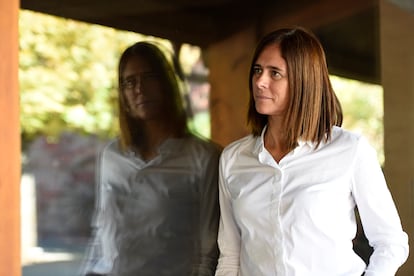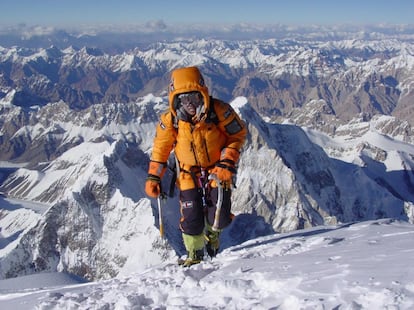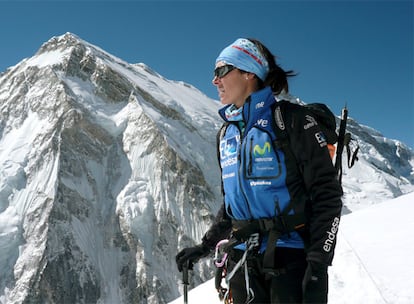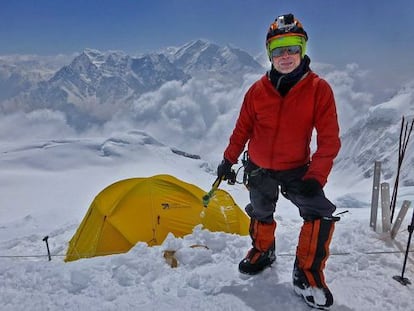Edurne Pasabán: ‘I faced death in the Himalayas, but I couldn’t find happiness’
The alpinist, first woman to climb the 14 eight-thousanders, talks about her depression and suicidal attempts and the importance of caring about one’s mental health

Edurne Pasabán has faced peaks higher than the 14 eight-thousanders that she became the first woman to climb. After overcoming a depression that brought her to the brink fo suicide, the 48-year-old mountaineer now enjoys time with her five-year-old son Max. She shared her experience with the elite sport and mental health.
Question. Who is Edurne Pasabán today?
Answer. A girl who fought for her passion, to climb mountains, and made her passion her life purpose. Today I didn’t climb eight-thousanders, but the mountain remains within me. What I learned I teach to others.
Q. How has becoming a mother changed you?
A. I am much more afraid. I have experienced a lot of extreme things. Before, I didn’t think about if something could happen to me, and now I do. I would love to go to the Himalayas for two months every year, but now I’m in another phase of life.
Q. Would you like your son to become a mountain climber?
A. Selfishly, no. I know the risks of what I’ve done, and I don’t want to suffer knowing that my son is there. My parents didn’t know about most of what we did, and they let us go. But I know it, and I don’t want to suffer. But if he wants to, I will support him.
Q. What are you most proud of in your career?
A. Of making a living on this. It was a tiny sport.
Q. Was being the first woman to climb all 14 a goal, a challenge, a business?
A. There were phases. At first, I was a 24-year-old kid with a dream, the Himalayas. It was an adventure story, a love story. Then [Spanish television documentary series] Al filo de lo imposible got started, and we became professionals. Until then I was just trying to make money to travel, selling t-shirts and raffle tickets. … Then another point came when I said that it wasn’t a game. I could keep going forward or I could go backward. I was becoming an adult. In 2007 the project of the 14 eight-thousanders was created. I had to market myself as the first woman to climb them, or I wouldn’t get sponsors. There was more pressure. The responsibility on my back got heavier. I started a competition with an Italian, and Austrian and a Korean who had a lot of resources. My expedition costed €130,000, and theirs to Annapurna cost €5 million, with satellite, live television… I had the same vacuum-packed ham that my mother had prepared for me.

Q. What was the payoff?
A. I started to make a living with this when I was 35, when athletes in other disciplines already would have retired. When I became a professional, it was a difficult moment for a woman, because at 31 or 32 society makes us feel like you have to find a partner and start a family. For my part, I spent seven months in the Himalayas putting my life on the line. And not just that, but my male colleagues could have it all. They had photos of their children at basecamp. That weighed on me.
Q. Is that where your depression began?
A. Yes, it was in 2006. Everything started because a partner left me. And I had to weigh something that I was passionate about against something else I desired. I fell in a hole and I blamed the mountain. People told me, “How are you going to find someone who waits for you when you go to the mountains?” It wasn’t that I was tired of the mountain or the pressure of finishing the 14. That year was the only one that I didn’t climb an eight-thousander. My internal battery died. I disconnected. I had a lot of help from my family and from the other eight-thousander people. They know that I had to convince myself to return.
Q. You do something that would be a dream for many.
A. Yes, but when someone is depressed, even though others tell you that you have everything going for you, you can’t see anything outside that hole. In 2007 they organized an expedition to Broad Peak. We summited and it was really beautiful. My references had been my lifelong classmates, who talked about their husbands, their children. When we went to dinner that was all they talked about. Some of them came with me to basecamp. It still makes me tear up. They told me, “Cut the nonsense. Get up there.” And I changed my attitude.
Q. How did you arrive at the point of wanting to end your life twice?
A. They were really tough times. On Monday I will turn 49. It’s incredible. Time passes super fast, and I don’t want to get older. I have so many things that I want to do, and there isn’t enough time. As I get older, I can’t do things like I used to and it annoys me. Literally, getting older annoys me. Thinking about this a few days ago, I went back to 2006 and asked myself, How did I try to end my life, saying that living isn’t worth it? Thankfully, it didn’t happen. I’m one of the lucky people who failed in trying to end my life, or else I wasn’t brave enough. What luck.
Q. Did you want to die or to end your pain?
A. To end my pain. It’s so big that you want to end it, and it’s the only way. If your leg hurts, you take a painkiller. That pain of the soul, inside of you, is really difficult to get rid of, and the ball grows and grows.
Q. You looked up how to do it. Does that scare you?
A. People scare me. Many people are experiencing the same situation today, going through the same thing I went through. I’m not scared right now. People who have experienced a mental illness can have the same thing again, but I know myself much better and I know that when the traffic light turns from green to yellow, I will have more knowledge about myself and feel calmer. And it has already happened to me. I’m not going to say that in the last 10 years I haven’t had to go back on antidepressants. When I have that anxiety or that anguish, I can control it more. The thought of trying to take my life now does not scare me, but everything I see outside does.
Q. What was your lowest point?
A. Entering a psychiatric hospital. Depression is still a taboo. If they were to detect a tumor, I’d go to treatment today. But when you have a mental illness and you have to take that step, it’s super hard. Your family, your environment, society does not accept it. When they admitted me, my brother made my father stop the car, saying how could they leave me in there. And my mother stopped going for coffee in the mornings with her friends so as not to give explanations. If I had had cancer and had undergone chemotherapy, it would not have been the same.
Q. You could face an eight-thousander, but not real life?
A. That’s it. Everybody told me that. I faced death every day in the Himalayas, I had lost many friends, five of us went on an expedition and four returned, but I could not structure my life and be happy. I could see a friend die in the mountains, but I couldn’t get over the fact that an uncle had left me, that my grandmother told me that I was going to miss the boat.
Q. Do athletes have to be invincible?
A. Yes and no. We are not invincible. We are real.
Q. What message do you want to communicate?
A. Ask for help. That is young people’s great problem. They do not ask for help, for fear of rejection.
Q. What is your fifteenth eight-thousander?
A. The most difficult and the most important of all, my son Max. I can forget the others, but this one is present every day. What makes Edurne Pasabán happy today is not the 14 eight-thousanders she climbed, but Max.

Helicoptering from a hotel spa to Everest
The queues on Everest and K2 scare Edurne Pasabán, a symbol of a time when loneliness could be found in the mountains. “Today it is a business. When I see those traffic jams I think how lucky I am to have experienced another time. There was nobody there, just a wall with 5,000 meters of rope. Those 145 people who summited K2 the same day are all crazy.”
Pasabán reflects on the new mountaineering, characterized by records and overcrowding: “It is not the quantity, but the quality, the ethics. We have seen the 14 eight-thousander climb in six months, but in that film you don't see that chaining Lhotse, Everest and Makalu is unfeasible if you don't use a helicopter, oxygen and a rope to the top. It took me 10 days to get to base camp on foot. Now you are in Camp 2 of Everest, at 6,500 meters, a helicopter takes you to the best five-star hotel in Kathmandu, you are in the spa in the afternoon and when you rest for four days it returns you to Camp 2. I remember spending four days with a girl with a broken hip, on a table, waiting for help”.
Tu suscripción se está usando en otro dispositivo
¿Quieres añadir otro usuario a tu suscripción?
Si continúas leyendo en este dispositivo, no se podrá leer en el otro.
FlechaTu suscripción se está usando en otro dispositivo y solo puedes acceder a EL PAÍS desde un dispositivo a la vez.
Si quieres compartir tu cuenta, cambia tu suscripción a la modalidad Premium, así podrás añadir otro usuario. Cada uno accederá con su propia cuenta de email, lo que os permitirá personalizar vuestra experiencia en EL PAÍS.
¿Tienes una suscripción de empresa? Accede aquí para contratar más cuentas.
En el caso de no saber quién está usando tu cuenta, te recomendamos cambiar tu contraseña aquí.
Si decides continuar compartiendo tu cuenta, este mensaje se mostrará en tu dispositivo y en el de la otra persona que está usando tu cuenta de forma indefinida, afectando a tu experiencia de lectura. Puedes consultar aquí los términos y condiciones de la suscripción digital.
More information
Últimas noticias
Tiger Woods turns 50: Will he continue playing on the PGA Tour or take a back seat?
The surreal journey of James Nnaji, the Barcelona youth player selected in the NBA Draft who ended up in the NCAA
Trump claims peace in Ukraine is near, but Moscow suggests otherwise
A survivor’s account of the Interoceanic Train accident: ‘We were scared because of the speed on the curve’
Most viewed
- Oona Chaplin: ‘I told James Cameron that I was living in a treehouse and starting a permaculture project with a friend’
- Reinhard Genzel, Nobel laureate in physics: ‘One-minute videos will never give you the truth’
- Why the price of coffee has skyrocketed: from Brazilian plantations to specialty coffee houses
- Pablo Escobar’s hippos: A serious environmental problem, 40 years on
- Chevy Chase, the beloved comedian who was a monster off camera: ‘Not everyone hated him, just the people who’ve worked with him’










































